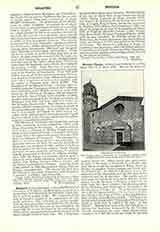

Niccola Pisano, architect and sculptor, b. at Pisa about 1205-07; d. there, 1278. He was the father of modern plastic art. When barely past adolescence, he came to the notice of Frederick II of Swabia who took him to attend his coronation in Rome, thence to Naples, to complete Castel Capuano and Castel dell’ Uovo (1221-31). In 1233 Niccola was in Lucca; the alto-rilievo of the Deposition over the side door of the cathedral may be of this date. The marble urn or Arco made to contain the body of St. Dominic in the church bearing his name in Bologna, is said to be an early work, but shows maturity; the charming group of the Madonna and Child upon it, foreshadows all the Madonnas of Italian art. From Niccola’s designs was built the famous basilica of St. Anthony in Padua, the church of the Feari in Venice is also attributed to him, possibly on insufficient grounds. In Florence he designed the interior of Sta. Trinity which Michelangelo loved so much that he called it his lady, “la mia Dama”. Having been ordered by the Ghibellines to destroy the Baptistery frequented by the Guelphs, Niccola undermined the tower called Guardo-morto, causing it to so fall that it did not touch the precious edifice. On his return to Pisa, the architect erected the campanile for the church of S. Niccolo which contains the remarkable winding stair unsupported at its center; an invention repeated by Bramante for the “Belvedere”, and by San Gallo in the renowned well at Orvieto. In 1242 Niccola superintended the building of the cathedral of Pistoja, and in 1263 the restoration of S. Pietro Maggiore. He remodeled S. Domenico at Arezzo, the Duomo at Volterra, the Pieve and Sta. Margherita at Cortona. Much of his work at Pisa is believed to have perished in the fire of 1610. A wonderful creation (1260) is the hexagonal, insulated pulpit of the Baptistery. It is supported by seven columns, three of them resting on lions. The panels have reliefs from the New Testament; the pediments, figures of virtues; the spandrels, prophets and evangelists. The architectural part is Italian Gothic: the sculptures are mainly pure reproductions of the antique. A second pulpit for the Duomo of Siena followed in 1266. Niccola’s early sculpture shows clumsiness, if we are to believe that the figures outside the Misericordia Vecchia in Florence are his. In later life, whether from Rome or from his own Camposanto at Pisa (Roman sarcophagus used for the Countess Beatrice of Tuscany; Greek vase with figures he reproduced) he learned to create with the freedom, beauty, and power of ancient art. Ruhmer suggests aptly that he may have used clay for his initial model, a method then unpracticed in Italy. One of Niccola’s last works in architecture was the abbey and church of La Scorgola, commemorating Charles of Anjou’s victory at Tagliacozzo, now in ruins; in sculpture, the statuettes for the famous Fonte Maggiore at Perugia, erected after his design (1277-80).
M. L. HANDLEY

